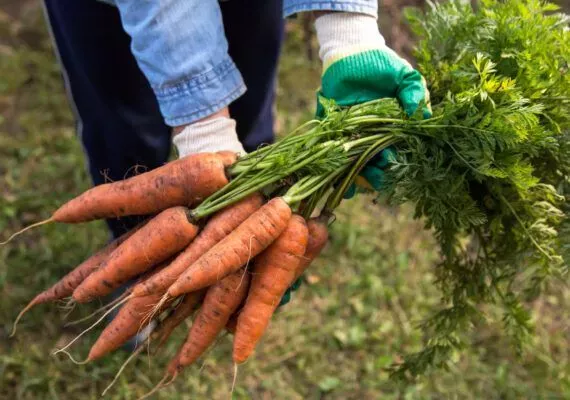
To prepare the field for carrot sowing, several important factors should be considered.
Liming
One of the most important procedures when preparing the field for carrot sowing is liming. Carrots grow best at a pH of 6.5 to 7.5. The calcium content in the soil should range from 1500 to 2000 mg/dm3. These conditions limit the uptake of cadmium and harmful nitrates from the soil by carrots.
The lime dose that should be applied to the field before sowing ranges from 500 to 1000 kg per hectare. Before applying any fertilizer to the field, soil testing in a laboratory should be conducted. Liming is also important due to the continuous acidification of soils in Poland. Since carrots do not like freshly limed soil, liming can be done in winter.
The Role of Nitrogen in Carrot Cultivation
Nitrogen is an important element for carrot growth. Its proper content in the soil helps to reduce the uptake of harmful substances from it. The dose to be supplied during fertilization ranges from 70 to 120 kg per hectare. The best form of nitrogen to supply to carrots is urea (amid). However, carrots should not be fertilized too intensively with nitrogen. It should also not be applied too late, as this contributes to the accumulation of harmful substances in the root.
Fertilization of Carrot Cultivation
Fertilization with phosphorus and potassium is necessary for carrot cultivation. The doses of these fertilizers range from 60 to 80 kg per hectare of phosphorus and from 150 to 200 kg per hectare of potassium. During cultivation, carrots can be foliar-fed with fertilizers containing micronutrients such as boron, copper, and manganese. This is done in the phase of 5 to 8 leaves. To reduce the uptake of unfavorable elements from the soil, carrots can also be pre-sown with manganese sulfate and post-rooted by applying a 0.5% manganese sulfate solution during growth.
Foliar Feeding and Limiting the Accumulation of Undesirable Substances in Carrots.
The best carrot yields are achieved after sowing on light and well-drained soils. In carrot cultivation, it is also important to adhere to crop rotation. Carrots can be sown after grains, corn, leeks, cabbage, cauliflower, or turnips. However, they should not be sown after vegetables such as potatoes, beans, peas, parsley, celery, beets, or Brussels sprouts.
To achieve carrot yields in the summer and autumn, it should be sown in April and May. Seeds can be sown on flat ground, but those sown on ridges yield 30% higher. This also protects the vegetable from heavy rainfall. Ridges are formed using an aggregate. The best height is from 20 to 25 cm and the width is from 20 to 30 cm. The spacing between ridges should be from 68 to 75 cm.
HOW TO CARE FOR CARROT CULTIVATION?
A very important procedure in carrot fields is weeding. The field should be weeded before sowing and also during the growth of the vegetable. Weeds are a major competition for growing carrots and cause yield losses. The greatest losses are noted from carrot emergence to the mid-vegetative period.
The weeds that cause the most damage in the vegetable plantation include bindweed, white goosefoot, wild mustard, common chickweed, field pansy, and common groundsel. The field can be weeded mechanically or by using appropriate herbicides that have the required certifications and have been registered.
Diseases
Various diseases can also threaten carrot crops. These include Alternaria blight, powdery mildew, and black root rot. Soil-borne diseases that can also harm carrot cultivation include common scab, Rhizoctonia, cavity rot, root blackening, or dry root rot. To prevent the occurrence of diseases, it is important to remember proper crop rotation, as well as weeding and using appropriate plant protection measures. Crop rotation has a significant impact on the profitability of crop production in Poland.
Pests
Real threats to carrot plantations are pests that can attack them. These include carrot flies, aphids, or soil-dwelling pests. Most of them overwinter in the soil, which is why deep winter plowing is such an important practice. Carrots should not be sown in the same location more than once every four years to limit the occurrence of pests. If they do appear, they can be lured to other places, deterred, or even chemically treated to neutralize them.
Harvesting
Carrot harvesting is done using special combines that can be set up in single, double, or triple rows. Some combines are equipped with top pullers. It is best to harvest on a sunny day, without precipitation. If carrots are harvested just after heavy rains, the storage time is shortened.
WHAT CARROT VARIETIES ARE BEST FOR INDUSTRIAL CULTIVATION?
Carrots can be divided into several categories, such as root shape and size, length of the vegetative period, and storage durability. Carrots can have round, oval, conical, cylindrical, or spindle-shaped roots. The length of these roots, depending on the variety, ranges from 4 to 35 cm, and the diameter from 3 to 7 cm. According to the type of roots, carrots can be divided into:
- Amsterdam
- Berlikum
- Chantenay
- Flakkee
- Imperator
- Kuroda
- Mini
- Nantes
- Parmex
- In our country, the most commonly grown types of carrots are Nantes, Berlikum, and Flakkee. The Nantes type has a high tolerance to high temperatures and low rainfall. It also shows resistance to powdery mildew. Berlikum has a uniform diameter of roots. Meanwhile, the Flakkee type consists mainly of industrial varieties with smooth and conical roots. Carrots can be classified according to the vegetative period as early, medium early, medium late, and late.
- The most commonly grown carrot varieties are:
- ’Anka’ – a late carrot intended for the fresh market and processing;
- ’Aksona’ – a late carrot, intended for the fresh market, processing (mainly frozen for children), and storage;
- ’Fatima’ – a late carrot intended for processing;
- ’Flamanka’ – a late carrot intended for processing and storage;
- ’Galicja’ – a medium-early carrot intended for the fresh market, processing, and storage;
- ’Kalina’ – an early carrot intended for the fresh market (bunched harvest) and processing (juices, salads);
- ’Kamila’ – an early carrot intended for the fresh market (bunched harvest) and processing (juices and salads for children);
- ’Rumba’ – a medium-early carrot intended for the fresh market, processing, and storage;
- ’Salsa’ – a late carrot intended for processing (frozen, juices, dried) and storage.






